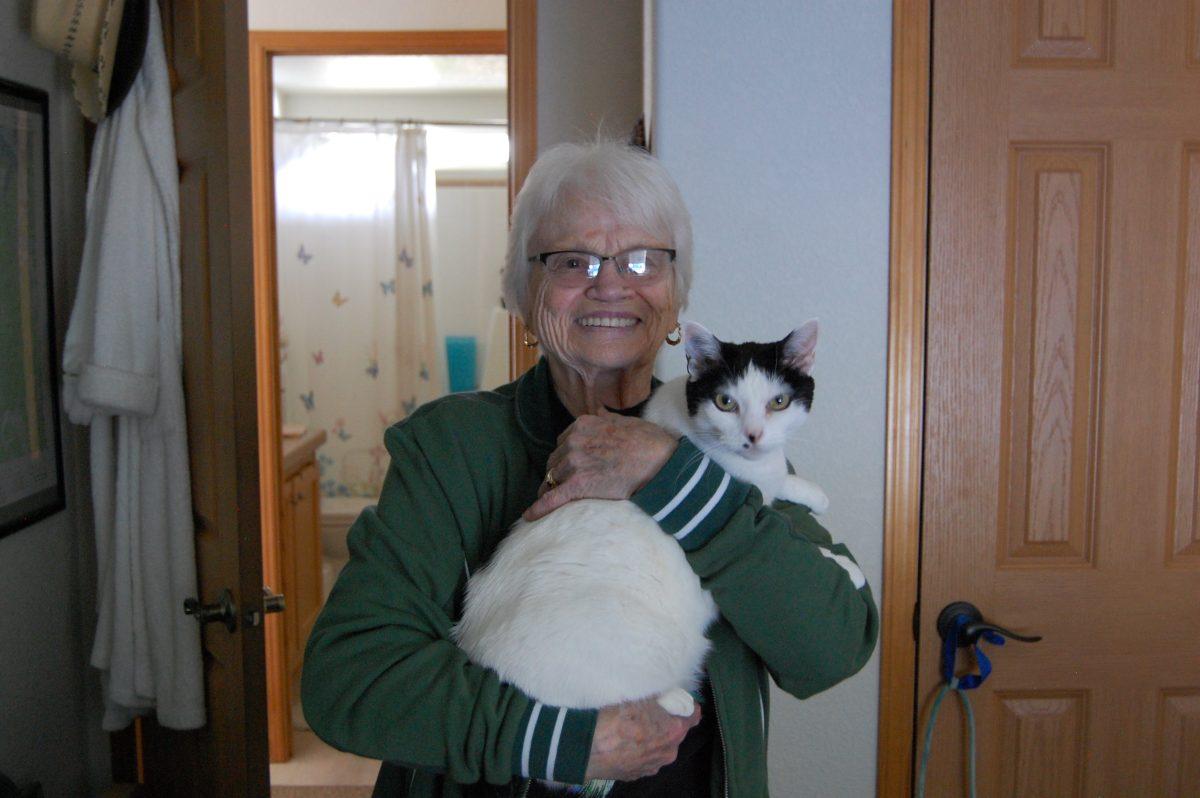On Feb. 11, 2023, Will Garrahan was fired from the University of Oregon dining services for taking a bowl of food.
Garrahan, a former dining hall worker, had taken the bowl four days earlier. In the middle of working an 8 to 10 pm shift at the Global Scholars Hall bowl station, Garrahan made himself a bowl at 8:30, as all the hot food is thrown away at 9. Garrahan brought the bowl to an area behind the food station where employees often store their belongings when a coordinator saw him and reported him. Garrahan, along with all UO employees, had signed a contract stating he couldn’t steal any university property while working. Food is not an exception.
“It’s just funny I get to work the line all day, but I don’t get to eat the food I’m working with,” Garrahan says.
Garrahan’s story is merely a piece of the puzzle that currently composes the relationship between student workers and the university. Beginning in fall 2021, dining hall workers, resident assistants (RAs), dorm employees and other student workers came together to unionize. Their desires include better and more frequent pay, improved harassment and rule-breaking policies and an increase of resources. Currently, they are in the midst of unionizing as a group.
According to the U.S. Department of Labor, a labor union is “a group of two or more employees who join together to advance common interests such as wages, benefits, schedules and other employment terms and conditions.” For UO student workers, being part of a union has meant doing everything in their power to create a better and healthier working environment for themselves, and future classes to come.
The UO currently has over 4,000 student workers dispersed throughout the dorms, dining halls, campus buildings and more. An estimated 3,800 of them are a part of the union.
The desire to unionize among students is not uncommon, and Grinnell College, a liberal arts school in Iowa, paved the way.
In April 2022, Grinnell College became the first independent undergraduate labor union in the country. After first unionizing in 2016, they ran a campaign two years later to expand the group. The vote passed and the local Region 18 National Labor Relations Board (NLRB) in Minneapolis, Minnesota, sided with the students, but the school appealed to larger authorities in the former president Donald Trump-appointed NLRB.
“We backed down,” says Kelly Banfield, a member at large of the Union of Grinnell Student Dining Workers (UGSDW).
Despite the challenge, the union persisted through the next five years and proved that a student-driven campaign can make significant changes within a university.
“The presence of a union on campus makes you more aware of your rights as a student worker,” Banfield says. “I think it’s helped me better advocate for myself and others.”
Kenyon College in Ohio, Dartmouth College in New Hampshire and Barnard College in New York are a few of the universities that have followed suit in labor organizing amongst their undergraduate dining hall workers. Additionally, graduate students at private universities earned the right to unionize in 2016 after a ruling within Columbia University.
The key difference between all these successful schools and one like UO is student body size. UO has about 15 times more students than some of the aforementioned private schools. Therefore, it’s much harder to unionize.
Garrahan joined the campaign a little over a year ago after hearing about it through the Young Democratic Socialists of America (YDSA) chapter through the UO. At that time, the campaign existed mainly to improve working conditions for student workers. The Union of Student Workers was formed, and over time became known as “the union.” At that early time, just under a dozen people belonged to the group — some, like Garrahan at the time, weren’t even student workers.
“I wanted to help the world around me, and I’m a big fan of unions,“ Garrahan says. “I joined because I wanted to make a difference, and I still feel that way, although it’s been a rough year plus at this point.”
When Garrahan joined, student workers in the campaign were advocating for better representation in the Associated Students of the University of Oregon (ASUO). Members believe that the interests and priorities of the ASUO didn’t align with true issues amongst students, requiring a need for better representation. The effort ultimately failed, but according to organizers like Garrahan, it didn’t slow the union fighting for other causes.
A frequent complaint among student workers has been the frequency of their paychecks.
UO’s student worker policy sees that they are paid just once a month, on the last working day of each month. They’re paid for the work they did on the 16th of the previous month to the 15th of the current month, so if a student only worked the back half of the month, they’d have to wait over a month to get paid. This directly violates Oregon law 652.120, which claims that “payday may not extend beyond a period of 35 days from the time that the employees entered upon their work.”
Students are also allowed to work 25 hours maximum a week, which can’t fully financially support many.
The limit in hours, combined with the infrequent payments, creates a difficult budgeting situation for many students.
“We’re young adults,” Garrahan says. “We don’t have savings. Our jobs don’t pay us enough to be able to be paid monthly, and I think it’d make more sense to be paid bi-weekly like other people our age.”
Brennan Furber, a worker at the UO Student Recreation Center, agrees. He’s one of many student workers to have a second job, one that pays him bi-weekly.
“Budgeting is extremely difficult,” Furber says. “Especially because I feel like I’m one of the only college students that has to pay for my own stuff. I pay my rent, phone bill, car insurance, so on a monthly stipend, it’s really tough.”
Another complaint from Garrahan, although he never experienced it himself, was dining hall management misgendering staff. He, and Carolyn Roderique, an RA of two years and an organizer for the union, also brought up the inconsistency of management, specifically with disciplinary actions.
Garrahan noted a large turnover rate among workers in the dining halls even though he only worked there for over eight months. No call, no shows were common among workers, yet some would never get followed up with or disciplined.
A month after Garrahan’s own firing, a protest was held outside the EMU fishbowl among furious Starbucks employees.
An employee who’d previously been a student at the UO and had seven years of experience working at Starbucks was fired for using an inappropriate word in front of customers, but it was a month and a half after the fact. The underlying suspicion behind the firing was student unionization, as this employee was part of the campaign.
Once coworkers were aware, they stopped their demanding jobs temporarily and went outside on strike, which received local press.
“I saw something about how it’s one of the largest campus unionization efforts in the U.S.” Furber says. “It definitely deserves press. What it could mean for other schools, campuses and unions could be really impactful.”
Prior to the Starbucks protest, around the same time as Garrahan’s firing, an issue arose between the UO and RAs. While promised a raise from the university, many RAs joined the unionizing efforts, and subsequently, the UO never paid the raise. The RAs had actually won the case for the raise before any of them started filling out union cards, but many decided to join the union once their demands weren’t met. The connection between unionization and lack of pay was never explicitly mentioned and documented, although most RAs and organizers suspect they are related.
“I don’t really think there are words for something like that,” Roderique says. “We just feel disposable to them. That’s a word a lot of us RAs have come up with. We’re disposable to them, and they treat us like we’re disposable.”
According to Roderique, she was first told that unionizing was the sole reason for the lack of a raise, but later, she was told it was just part of the reason. When the university has been asked to comment on student unionization, they’ve reportedly stayed neutral on the issue, telling local media that they don’t take a position on it. However, even the simplest protest efforts, like unionization pins, have been banned among student workers.
“They say they’re neutral on student unionization, yet they take away this pay raise because we’re unionizing,” Roderique says. “It doesn’t make much sense.”
Besides housing and food costs, RAs get just a $100 stipend each month. According to Roderique, they also haven’t received a raise since the 2019-20 school year. A survey amongst RAs was conducted last fall by the Student Leadership Council, and the results showed that over 90% of RAs felt finally insecure and 48% had a second job.
“We’re not fairly compensated at all for how much we keep this place together,” Roderique says. “There’s also just not enough mental health resources and follow ups for RAs because of things like sexual assault, stalking, domestic violence, suicidal ideation. Those are all things we can and do deal with on the job, and something we’re not well supported with.”
Dealing with medical personnel, intoxicated underage students and loud or destructive students are just a slice of the endeavors an RA deals with on a daily basis. According to Roderique, some have been physically assaulted by students. RAs that are heavily involved and outspoken in the union, like Roderique, risk their working and living situation daily by fighting for what they believe is right.
Roderique has openly advocated for RAs for over a year, but many of the complaints haven’t gone anywhere. She says that there’s been times where RAs complaints are met by the housing department with comments about how being an RA at other universities is far worse, or that back in their day, being an RA was much worse, in general.
When Roderique joined the union this past November, she finally felt listened to.
Currently, the union and the UO are trying to work together on a bargaining unit, or a collective number, that will clarify what union cards will count and which won’t, but it hasn’t been easy. On May 1, the UO sent out an update stating that the bargaining unit would only include students who worked an average of four hours per week over three consecutive months, which would result in about 700 of 4,000 student workers total.
Once it’s clarified which cards will and won’t count, other factors such as timeliness and legalities will play a large role in the unionization process. If a majority of student workers in the bargaining unit don’t have a signed card, it would trigger an election within workers in the bargaining unit to determine whether or not they’re able to unionize, yet this would take around 45 additional days for the university to prepare for and advertise, according to Garrahan.
He also added that the unit would like to avoid any longer delays as factors like summer break come into play, but at the end of the day, the university holds lots of power.
“One of the best tools for the university is that they have the advantage when it comes to timing,” Garrahan says. “Students leave campus, classes change, schedules change. Stalling just a little bit can be the difference between us winning a contract in 2023 or 2024.”
As for Garrahan himself, he’s currently looking for a new job outside of the dining halls, leaving behind some of his closest friends and coworkers from his time in food service.
For workers at Grinnell like Banfield, hardships from the university have become far too common.
“The college makes it really hard to organize,” Banfield says. “They’ve taken away our abilities to reserve rooms. We can’t reserve a table in front of the dining hall anymore, even though that’s allowed for all other groups. We kind of just float between spaces; it’s not an effective strategy.”
While the hearts of organizers in the union like Garrahan and Roderique are all about fighting for what they believe is right, it’s evident that the university could make it difficult for their efforts to be rewarded. For now, one of the best things they can continue to do is make both their individual and group efforts heard, for every student on campus.
“The university needs us to function, and without us, they really don’t have anything,” Garrahan says. “Who’s going to work the dining halls? Students should be aware because it’s a force for change. Hopefully it will be able to change the university and make it better for students.”
A Starbucks union sign is seen on a telephone pole on Franklin Blvd, in Eugene, OR.











![[Photo Courtesy of the Lara Family]
Ruben embraces his beloved childhood goat, Katrina.](https://ethos.dailyemerald.com/wp-content/uploads/2025/05/katrina-1-1060x1200.jpg)


